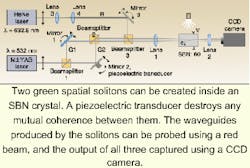Researchers at Darmstadt University of Technology (DUT), Germany, have demonstrated the use of photorefractive (2+1)D-solitons as a means of providing rewritable waveguides. Experiments have included a demonstration of all-optical switching through the interaction of two solitons, splitting of one beam into two, and guidance of a beam along a residual soliton track. Though the current implementation has little practical value because of its speed, researchers hope that similar devices will eventually be made with much faster materials.
The solitons used in this project are not the same solitons that we are used to—pulses designed to keep their temporal shape through dispersive media. Instead, spatial solitons are beams of light that maintain their cross-sectional profile through a photorefractive medium because the dispersion effect is compensated for by self-focusing. In particular, the Darmstadt work was based on something called a spatial screening soliton. Here, the photorefractive crystal has an electric field across it, but this field is "screened" by the production of charge carriers liberated by the light beam. The graded refractive-index profile produced is very similar to the intensity profile of the beam. The result is a spatial soliton.
One of the simplest uses of this phenomenon is the production of a waveguide in a relatively slow-erase photorefractive material. Even when the soliton itself is gone, the graded-index structure remains. This can now be used to guide other light beams that do not interact nonlinearly with the material in question—a red HeNe laser beam, for instance, was used as a nondestructive probe of green (frequency-doubled Nd:YAG) soliton waveguides in SBN:Ce (Sr0.60Ba0.40Nb2O6 doped with 0.002 wt.% CeO2). Not only do probe beams follow the same path as the green solitons that went before them, they also emerge from the crystal with the same beam shape.
In order to allow for solitons to be produced dynamically, researchers have to make sure that any inactive waveguides (refractive index variations that are not related to current solitons) are continually erased. This way, solitons are free to evolve and the probe beam only follows the new path. This erasure is performed by exposing the photorefractive crystal to white light that has about the same intensity of the green writing light.
The setup at the Light and Particle Optics Group, part of the Institute of Applied Physics at DUT, allows the formation of solitons to be recorded (see figure). As the green write-beam slowly self-focuses and stabilizes, so the red eventually emerges as a clean beam following the same path—the whole operation taking several seconds. An interesting feature of this process is that, as well as the shape of both write and probe beams changing during soliton formation, the position of the output shifts. This shows that the path itself has altered.
All-optical switching
Another experiment demonstrates how the system could be used for all-optical switching. Two parallel soliton beams were allowed to form: these interacted strongly, and rotated around each other by 60°. When the probe was introduced, however, the two soliton paths were found to be independent. The red beam would travel down one path or another, but not both. Because the presence of one soliton changed the path of the other, two write beams could be considered the guide and the control. One sets the path for the probe; the other alters that path based on its presence or absence.
Independence between waveguides is not necessary, however—energy exchange between solitons can also be useful. In a third experiment, the relative angle and distance between the solitons was engineered so that the probe beam would travel through both paths despite being injected into just one. Since the output is evenly split, the photorefractive soliton system is acting as a 1-to-2 waveguide divider.
Though the Darmstadt team has provided proof of the concept, much remains to be done to make the technology practical for real applications.
About the Author
Sunny Bains
Contributing Editor
Sunny Bains is a contributing editor for Laser Focus World and a technical journalist based in London, England.
